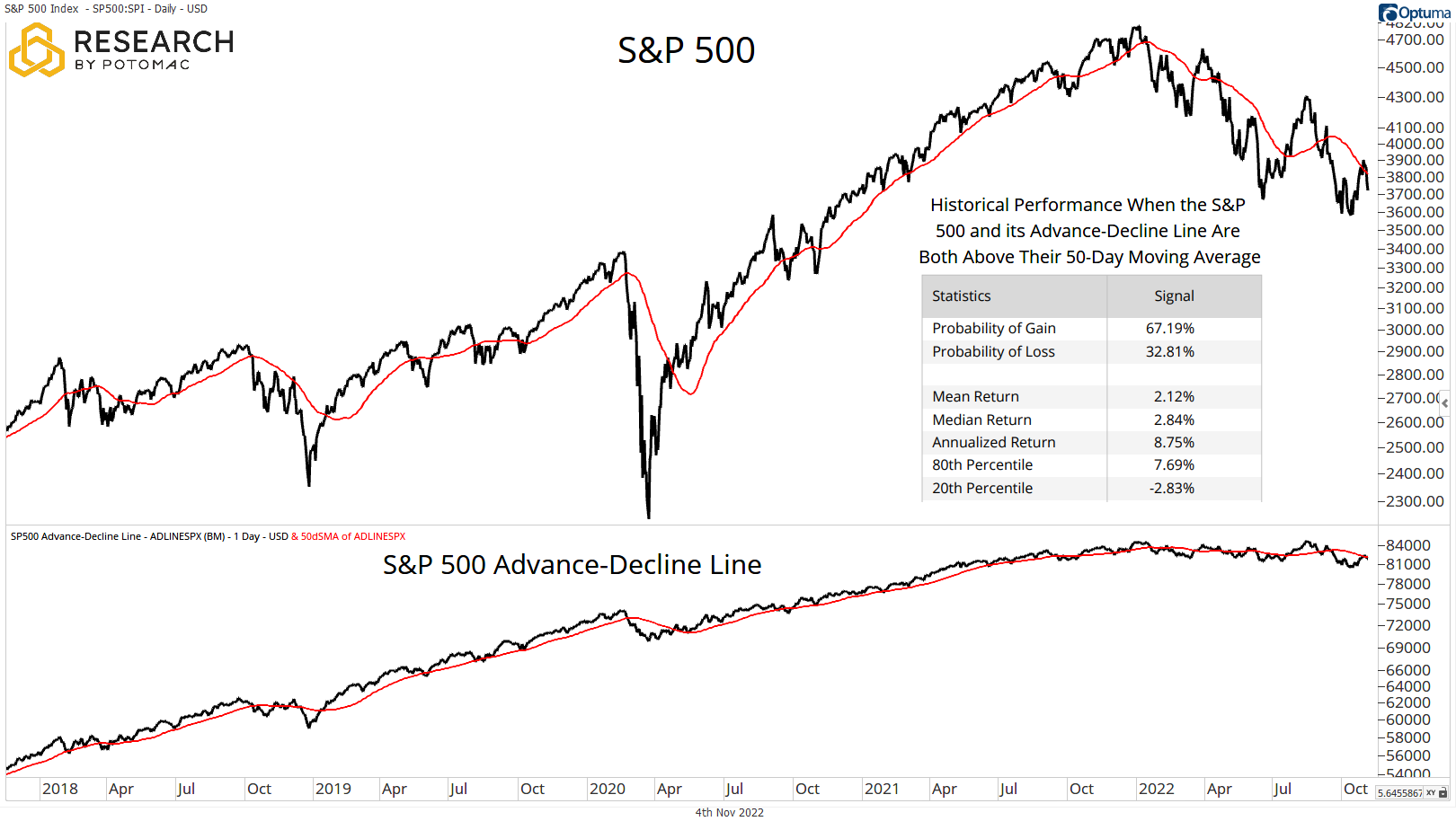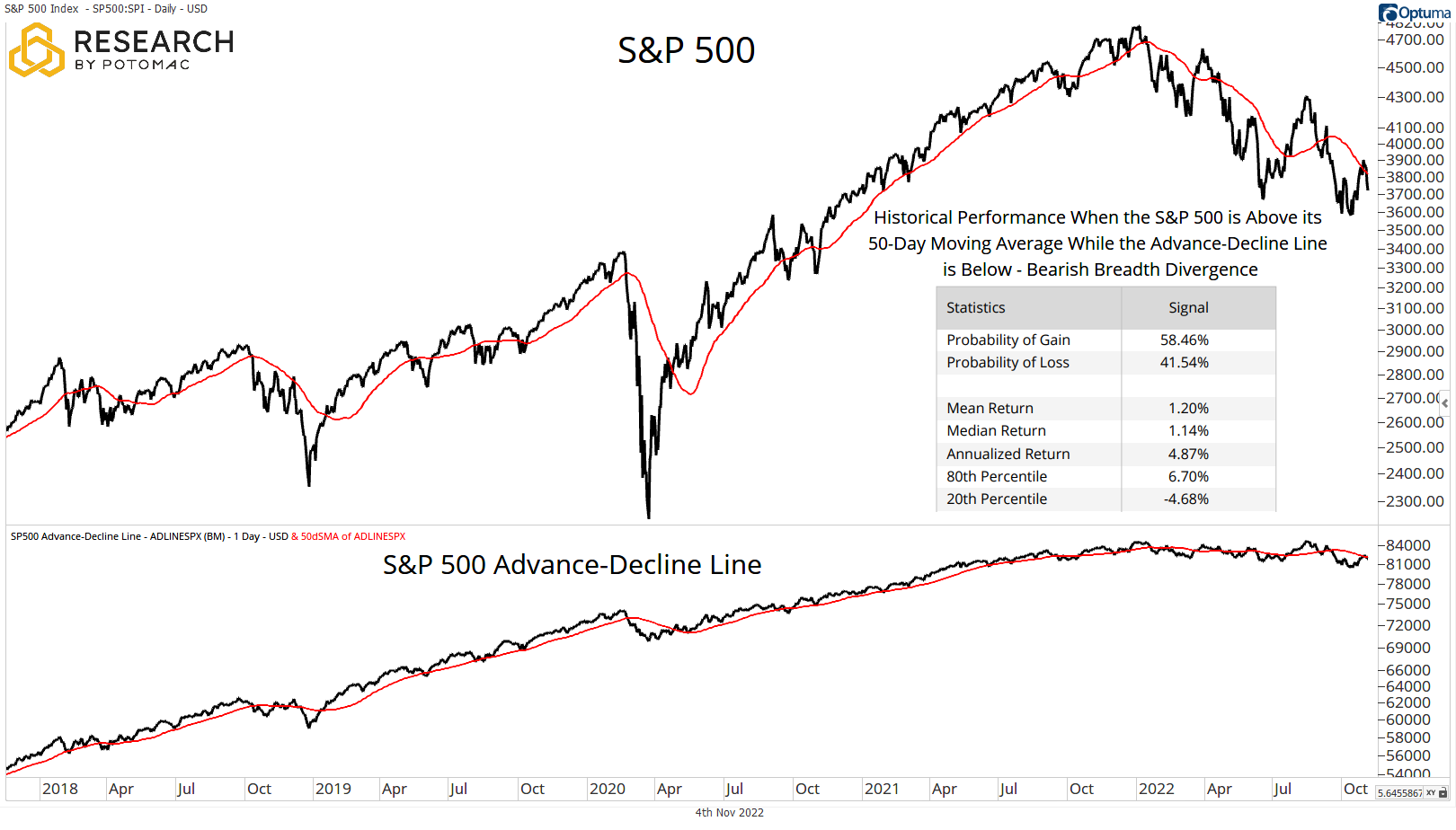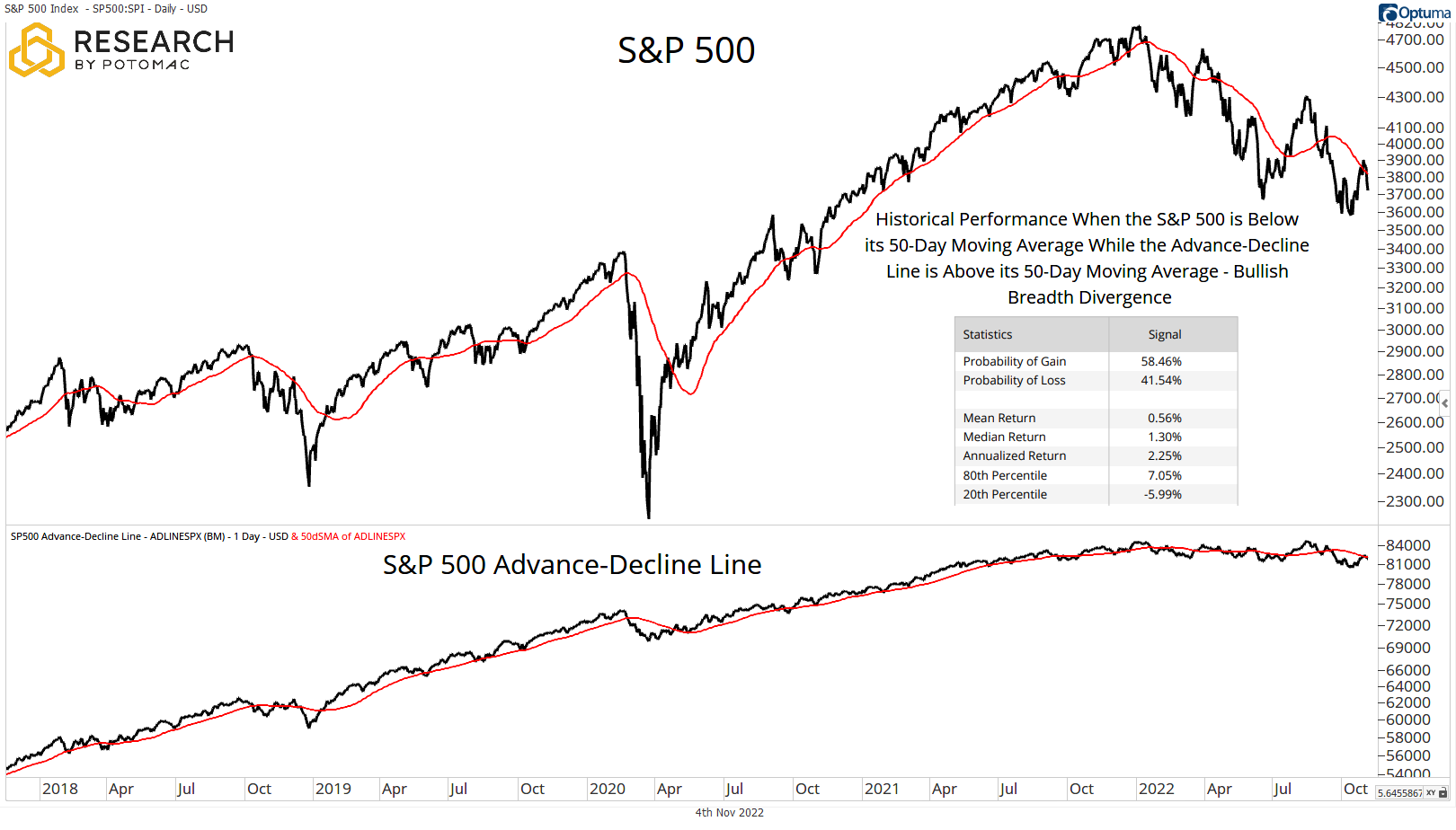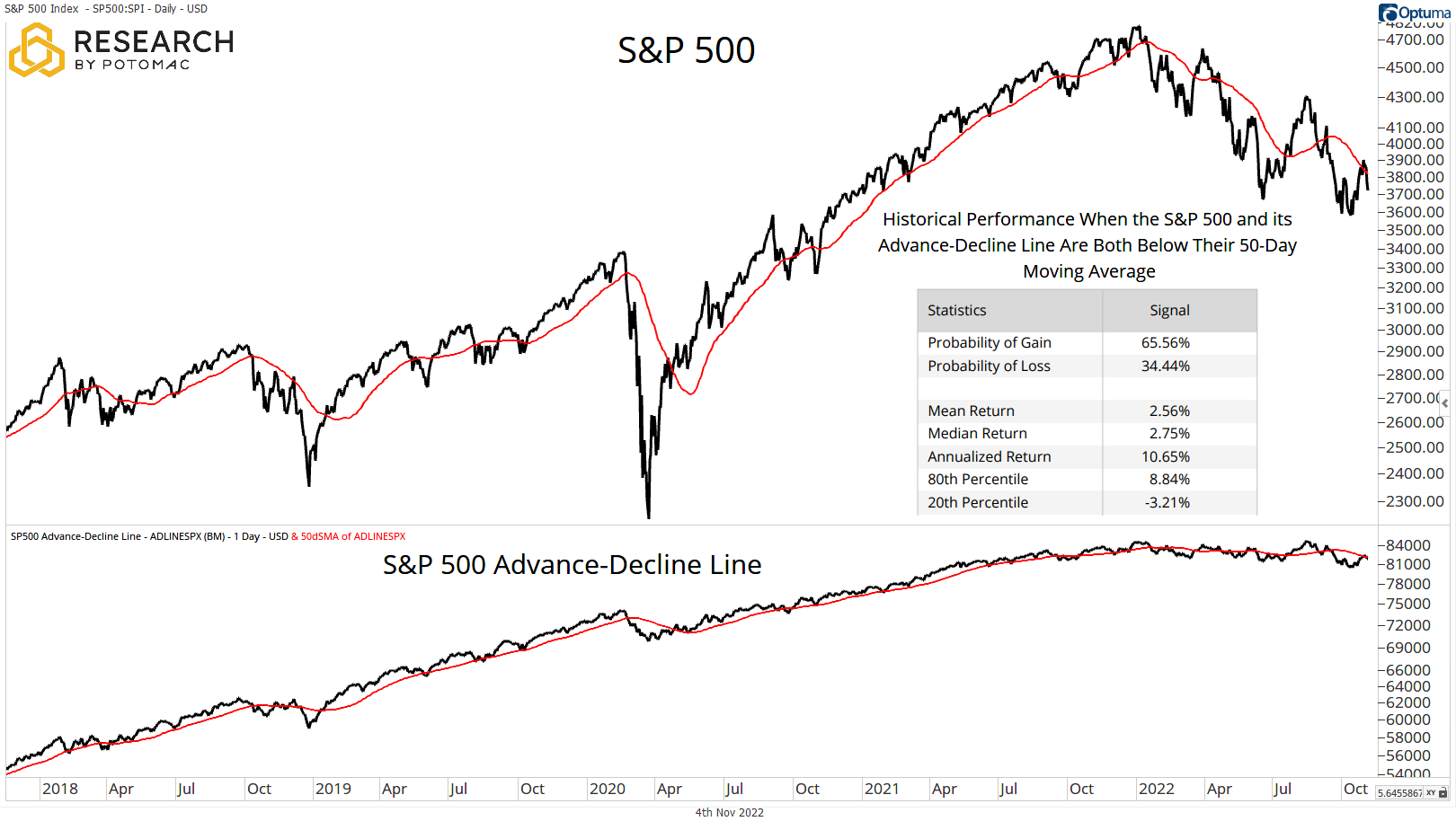
Market Breadth has been the subject of many technical and quantitative studies within capital markets over the last several decades. In our previous article, we looked specifically at Breadth Thrusts and the risks associated with these events. While breadth thrusts are important, they are not the only breadth developments that can be measured.
Market Breadth is often associated with market health. For example, if an equity index has been trending higher over time, investors often gain confidence when a greater number of stocks are participating in the uptrend. Conversely, a decline in a breadth metric can take confidence away from and uptrend.
Before diving into the test results, it’s important to outline the mechanics of the breadth metric that will be utilized for the S&P 500. The Advance Decline line is one of the oldest technical breadth indicators and has been utilized by analysts and managers alike for decades; the indicator takes the difference between advancing and declining stocks on a given trading day and plots this data on a cumulative basis over time.
In this article, we are reviewing the historical returns and risk when the S&P 500 and its Advance Decline Line are confirming each other, and when they have diverged from each other. Confirmation will be defined as when the S&P 500 and its Advance Decline Line are both above and below their 50-day moving averages. Non-confirmation will be defined as when the S&P 500 is above its 50-day moving average while its Advance Decline Line is below its 50-day moving average, or a “bearish breadth divergence”, in addition to reviewing instances when the S&P 500’s Advance Decline line is above its 50-day moving average while the S&P 500 is below, or a “bullish breadth divergence.”
While there are many indicators and indices that can be utilized to measure market breadth (and ones that we will likely test over time) the simplest, and oldest, methods are still highly relevant to this day. Historically, market analysts have utilized the Advance-Decline Line in a discretionary fashion, highlighting divergences and confirmations as they see them utilizing years of market analysis skill. For this article, in usual fashion, we prefer a more systematic approach.
Historical Performance When the S&P 500 and Advance-Decline Line Are Both Above Their 50-Day Moving Average
There were 6,939 instances since 1968 where both the S&P 500 and its Advance-Decline Line were above their 50-day moving average for a median gain in the S&P 500 of 2.84% with a 67.19%-win rate over the following quarter, with 20th percentile returns coming in at a loss of -2.83%.

*Data via Optuma as of the close of business 11/3/2022
Historical Performance When the S&P 500 is Above its 50-Day Moving Average While the Advance-Decline Line is Below – Bearish Breadth Divergence
There were 1,726 instances since 1968 where the S&P 500 was above its 50-day moving average while its Advance-Decline Line was below its 50-day moving average, or a “bearish divergence”, for a median gain in the S&P 500 of 1.14% with a 58.46%-win rate over the following quarter, with 20th percentile returns coming in at a loss of -4.68%. Note that when a bearish breadth divergence has been in place, historically, both median gains and win rates have been significantly lower combined with deeper losses at the 20th percentile suggests that a bearish breadth divergence is an environment of increased risk for the S&P 500 compared to when both indexes are trading above their 50-day moving average.

*Data via Optuma as of the close of business 11/3/2022
Historical Performance When The S&P 500 is Below its 50-Day Moving Average While its Advance-Decline Line is Above the 50-Day Moving Average – Bullish Breadth Divergence
There were 1,015 instances since 1968 where the S&P 500 was below its 50-day moving average while its Advance-Decline line was above its 50-day moving average for a median gain in the S&P 500 of 1.30% with a 58.46%-win rate over the following quarter, with 20th percentile returns coming in at a loss of -5.99%. Note that while this development, or “bullish breadth divergence” has often been interpreted as a carte blanche bullish development, history suggests otherwise. Note that while the win-rates were the same, compared to a bearish breadth divergence, the median gain on a bullish breadth divergence was only 16bps better, while 20th percentile declines were deeper at -5.99% for a bullish breadth divergence, suggesting heightened risk compared to a bearish breadth divergence.

*Data via Optuma as of the close of business 11/3/2022
Historical Performance When the S&P 500 and its Advance-Decline Line Are Both Below Their 50-Day Moving Average
There were 4,071 instances since 1968 where the S&P 500 and its Advance-Decline Line were both below their 50-day moving average for a median gain in the S&P 500 of 2.75% with a 65.56%-win rate over the following quarter, with 20th percentile losses coming in at -3.21%.

*Data via Optuma as of the close of business 11/3/2022
Bringing it All Together
When the S&P 500 and the Advance/Decline Line are simultaneously above or below their 50-day moving average, median gains are within 9bps of each other. However, 20th percentile declines are slightly deeper when the S&P 500 and its Advance-Decline Line are both below their 50-day moving averages than when they are both above. This lends some degree of credence to a heightened risk environment when the index and A/D Line are both below the moving average.
It becomes more interesting when a bearish breadth divergence is in play – when the S&P 500 is above its 50-day moving average while its Advance-Decline Line is below. Compared to when they are both above their 50-day moving average, win-rates have been significantly lower at 58.46% vs. 67.19%, median gains were significantly lower at 1.14% vs. 2.84%, and 20th percentile declines were deeper at -4.68% vs. -2.83%. These results are suggestive that a bearish breadth divergence, by this measure, have historically been an unfavorable condition for the S&P 500.
Since a bearish breadth divergence has historically been unfavorable, it should stand to reason that the inverse – a bullish breadth divergence – should be a favorable development for the S&P 500. Unfortunately, history suggests that this has not been the case. Compared to when the S&P 500 and its Advance-Decline Line are both below their 50-day moving averages, a bullish breadth divergence has historically produced lower median gains at 1.30% vs. 2.75%, lower win-rates at 58.46% vs.65.56%, and deeper 20th percentile losses at -5.99% vs. -3.21%.
Does this work suggest that all bullish breadth divergences have been invalidated? Of course not. There are a multitude of various breadth measurements and conditions that can be tested that could likely yield different results. This work, however, does detract evidence from the technical analysis lore that all bullish breadth divergences should be initially interpreted as bullish.
Potomac Fund Management (“Company”) is an SEC-registered investment adviser. This information is prepared for general information only and should not be considered as individual investment advice nor as a solicitation to buy or offer to sell any securities. This material does not constitute any representation as to the suitability or appropriateness of any investment advisory program or security. Please visit our FULL DISCLOSURE page. The company does not make any representations or warranties as to the accuracy, timeliness, suitability, completeness, or relevance of any information prepared by any unaffiliated third party, whether linked to the Company website or incorporated herein, and takes no responsibility for any of this information. The views of the Company are subject to change and the Company is under no obligation to notify you of any changes. Different types of investments involve varying degrees of risk, and there can be no assurance that the future performance of any specific investment or investment strategy will be profitable or equal to any historical performance level.
